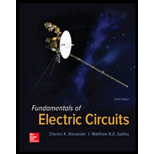
In the circuit of Fig. 16.76, the switch has been in position 1 for a long time but moved to position 2 at t = 0. Find:
- (a) v(0+), dv(0+)/dt
- (b) v(t) for t ≥ 0.
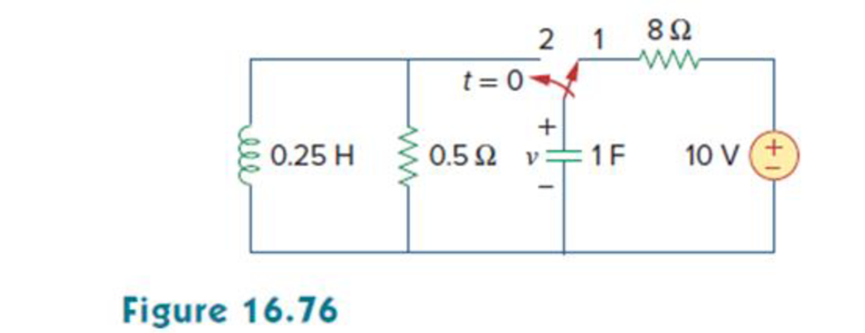
a.
Find the value of
Answer to Problem 53P
The value of
Explanation of Solution
Given data:
Refer to Figure 16.76 in the textbook.
The switch is in position 1 for a long time and moved to position 2 at
Calculation:
The given circuit is redrawn as shown in Figure 1.
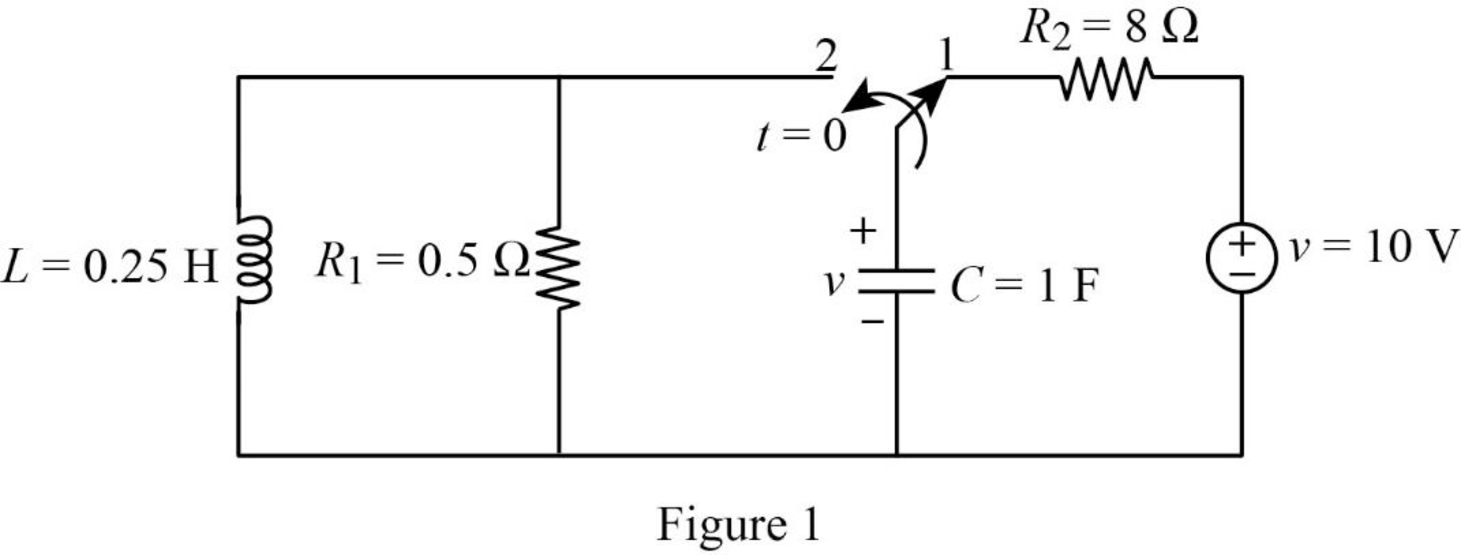
For a DC circuit, at steady state condition when the switch is in position ‘1’at time
Now, the Figure 1 is reduced as shown in Figure 2.
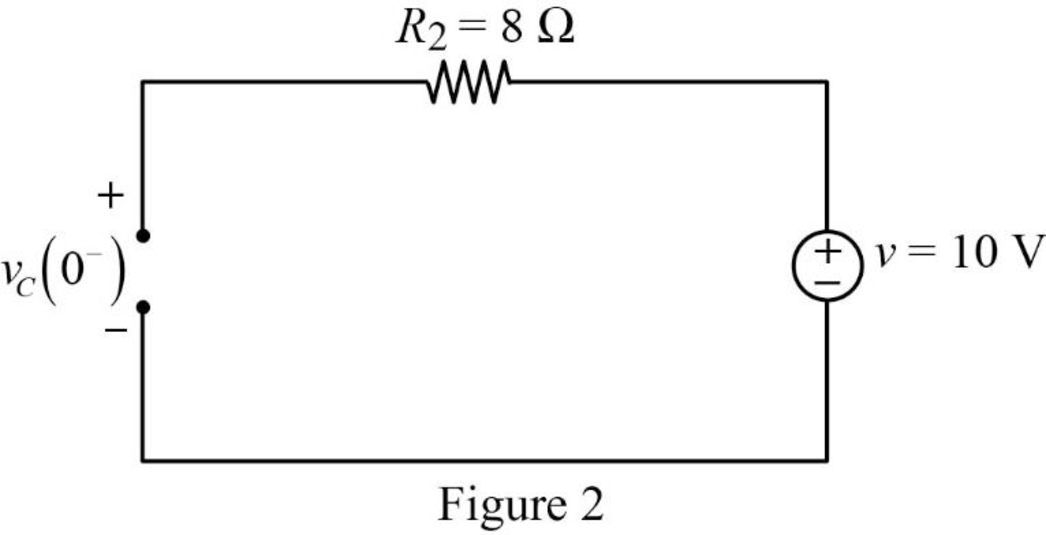
Refer to Figure 2, the voltage across the resistor is same as the voltage across the capacitor which is the source voltage.
The current through inductor and voltage across capacitor is always continuous so that,
When the switch is in position ‘2’, the Figure 1 is reduced as shown in Figure 3.

Refer to Figure 3, the capacitor, resistor and inductor are connected in parallel. For the parallel connection the voltage is same. In Figure 3, the magnitude of voltage is in opposite direction.
Apply Kirchhoff’s current law for Figure 3.
Substitute
Write an expression to calculate the current through resistor.
Substitute
Substitute
Substitute
At time
Rearrange the above equation to find
Substitute
Conclusion:
Thus, the value of
b.
Find the expression of voltage
Answer to Problem 53P
The expression of voltage
Explanation of Solution
Formula used:
Write a general expression to calculate the impedance of a resistor in s-domain.
Here,
Write a general expression to calculate the impedance of an inductor in s-domain.
Here,
Write a general expression to calculate the impedance of a capacitor in s-domain.
Here,
Calculation:
Substitute
Substitute
Substitute
Using element transformation methods with initial conditions convert the Figure 3 into s-domain.
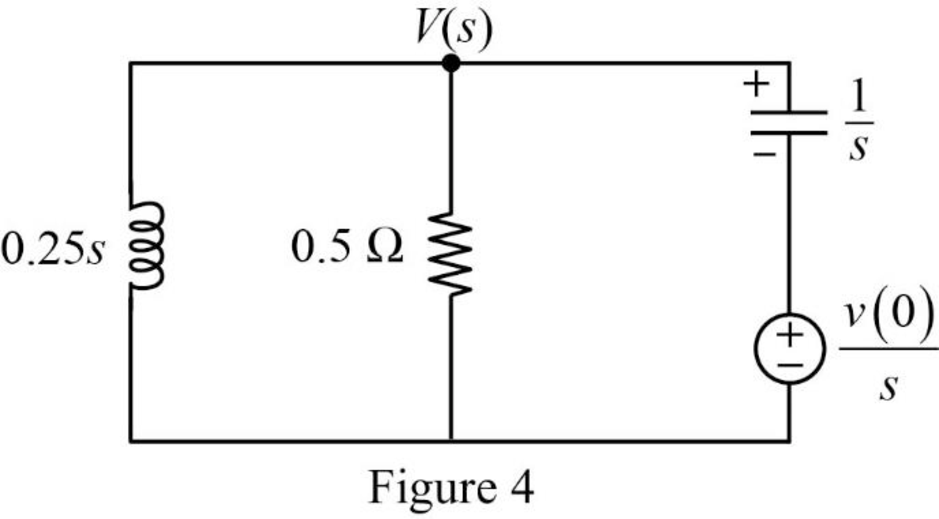
Apply nodal analysis at node
Substitute
Simplify the above equation to find
From the above equation , the characteristic equation is
Write a general expression to calculate the roots of quadratic equation
Comparing the equation (6) with the equation
Substitute
Simplify the above equation to find
Substitute the roots of characteristic equation in equation (5) to find
Take partial fraction for above equation.
The equation (8) can also be written as follows:
Simplify the above equation as follows:
Substitute
Simplify the above equation to find
Substitute
Simplify the above equation to find
Substitute
Take inverse Laplace transform for above equation to find
Simplify the above equation to find
Conclusion:
Thus, the expression of voltage
Want to see more full solutions like this?
Chapter 16 Solutions
Fundamentals of Electric Circuits
- Convert differential equations to transfer functionarrow_forwardObtain the transfer functions X1(s)/U(s) and X2 (s)/U(s) of the mechanical system.arrow_forward(Signals and Systems) Determine whether the systems with these transfer functions are stable, marginally stable or unstable by determining the poles.arrow_forward
- The switch in the circuit has been closed for a long time before opening at t=0. 1. a) Construct the s-domain equivalent circuit for t>0. 2. b) Find Io. 3. c) Find io for t≥0.arrow_forwardThe mathematical model of a system is 1y" (t) + 2y' (t) + 1y (t) = 1x' (t) + 2x (t) and the initial conditions are y(0) = 1 and y' (0) = 2. 1) Find the transfer function. 2) Find the system output when the input is Xt) = U(t).arrow_forwardAn 2 kΩ resistor, a 6.25 H inductor, and a 250 nF capacitor are inparallel. Express the s-domain impedance of this parallel combination asa rational function.arrow_forward
- A system whose dynamic equations dx(t)/dt = Ax(t) + Bu(t) y(t) = Cx(t) are given as . Find the eigenvalues of A. Find the transfer relationship between X(s) and U(s). Find the Y (s)/ U(s) transfer function.arrow_forwardThe following differential equations, r (t) input and y (t) output, refer to linear, time-invariant systems. Find the Y (s) / R (s) transfer function for each system.arrow_forwardFor a continuous time LTI system, the output is given as Y(s)=10(2s+3)/(s2+4s+5). Find out the final value of y(t) using final value theorem.arrow_forward
- 40 - When the unit step function is applied to the system input given the block diagram below, the output response takes the value c (infinity) = 3 for t = infinity. So which of the following can be the constants K, a?A) K = 0.05, a = 0.25B) K = 3, a = 1C) K = 0.35, a = 0.55D) K = 1, a = 3E) K = 0.45, a = 0.65arrow_forwardthe input output equation of this system is in the image find the solution of y(t) under the initial conditions y(0-) = -3, ŷ(0-) = 2, and x(t) = u(t)arrow_forward39 - When the unit step function is applied to the system input given the block diagram below, the output response takes the value c (0.2) = 0.145 for t = 0.2 s and c (infinity) = 0.8 for t = infinity. What is the time constant of the system? calculate.A) 1 sB) 2 sC) 0.5 sD) 0.25 sE) 0.33 sarrow_forward
 Introductory Circuit Analysis (13th Edition)Electrical EngineeringISBN:9780133923605Author:Robert L. BoylestadPublisher:PEARSON
Introductory Circuit Analysis (13th Edition)Electrical EngineeringISBN:9780133923605Author:Robert L. BoylestadPublisher:PEARSON Delmar's Standard Textbook Of ElectricityElectrical EngineeringISBN:9781337900348Author:Stephen L. HermanPublisher:Cengage Learning
Delmar's Standard Textbook Of ElectricityElectrical EngineeringISBN:9781337900348Author:Stephen L. HermanPublisher:Cengage Learning Programmable Logic ControllersElectrical EngineeringISBN:9780073373843Author:Frank D. PetruzellaPublisher:McGraw-Hill Education
Programmable Logic ControllersElectrical EngineeringISBN:9780073373843Author:Frank D. PetruzellaPublisher:McGraw-Hill Education Fundamentals of Electric CircuitsElectrical EngineeringISBN:9780078028229Author:Charles K Alexander, Matthew SadikuPublisher:McGraw-Hill Education
Fundamentals of Electric CircuitsElectrical EngineeringISBN:9780078028229Author:Charles K Alexander, Matthew SadikuPublisher:McGraw-Hill Education Electric Circuits. (11th Edition)Electrical EngineeringISBN:9780134746968Author:James W. Nilsson, Susan RiedelPublisher:PEARSON
Electric Circuits. (11th Edition)Electrical EngineeringISBN:9780134746968Author:James W. Nilsson, Susan RiedelPublisher:PEARSON Engineering ElectromagneticsElectrical EngineeringISBN:9780078028151Author:Hayt, William H. (william Hart), Jr, BUCK, John A.Publisher:Mcgraw-hill Education,
Engineering ElectromagneticsElectrical EngineeringISBN:9780078028151Author:Hayt, William H. (william Hart), Jr, BUCK, John A.Publisher:Mcgraw-hill Education,





